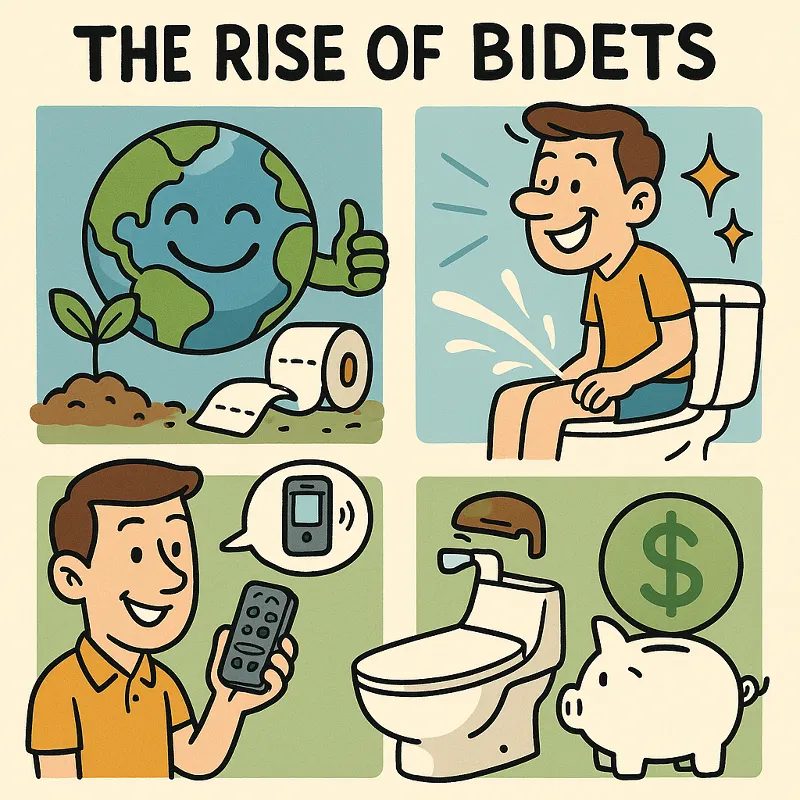
The Rise of Bidets
Bidets have long been a staple in many parts of the world, particularly Europe and Asia, but their popularity in countries like the United States has been relatively recent. This surge in interest can be attributed to a growing awareness of personal hygiene, environmental concerns, and the influence of global travel. The COVID-19 pandemic also played a role, as toilet paper shortages prompted consumers to seek alternative hygiene solutions. This shift in consumer behavior has opened new opportunities for bidet manufacturers and marketers who are eager to tap into this evolving trend.
Changes in Bidet Adoption in American Households Post-Pandemic 👆Environmental Benefits
One of the most significant advantages of bidets is their environmental impact. Traditional toilet paper production involves deforestation, water consumption, and chemical processing, all of which contribute to environmental degradation. Bidets, on the other hand, use a minimal amount of water for each wash, which is significantly less than the water used in the production of toilet paper. By reducing reliance on toilet paper, bidet users can contribute to a decrease in deforestation and water pollution. This eco-friendly angle has become a central theme in bidet marketing, appealing to environmentally conscious consumers who are eager to reduce their carbon footprint.
Bidet Use Debate from a Religious Perspective 👆Health and Hygiene
Bidets offer superior hygiene compared to toilet paper. They provide a more thorough cleaning, reducing the risk of bacterial infections and skin irritation. For individuals with certain medical conditions, such as hemorrhoids or mobility issues, bidets offer a gentle and effective cleaning solution that minimizes discomfort. Marketing campaigns often highlight these health benefits, positioning bidets as essential for maintaining personal hygiene. This focus on health has resonated with consumers, particularly in the wake of the pandemic, where hygiene has become a top priority for many.
Comparison of Bidet Usage Habits in Europe and Asia 👆Technological Innovations
Smart Bidets
The integration of technology into bidets has transformed them from simple cleaning devices into smart appliances. Features such as adjustable water temperature, pressure settings, air dryers, and deodorizing functions are now standard in many modern bidets. Some models even come equipped with remote controls or smartphone apps for personalized settings. This technological advancement has increased the appeal of bidets, particularly among tech-savvy consumers who appreciate the convenience and customization options that these devices offer. Marketing strategies often emphasize these features to attract a younger, more tech-oriented audience.
Analysis of Factors Driving Growth in the US Bidet Market 👆Cost-Effectiveness
While the initial investment in a bidet may seem high, it can lead to significant long-term savings. By reducing or even eliminating the need for toilet paper, users can save money on household supplies. Additionally, the longevity of bidets, coupled with minimal maintenance costs, makes them a cost-effective option for consumers. Many marketing campaigns focus on these savings, providing potential customers with a clear financial incentive to make the switch. For budget-conscious consumers, the promise of long-term savings can be a compelling reason to adopt bidet technology.
History and Present of Japanese Bidet Culture 👆Challenges in Marketing
Cultural Perceptions
Despite their benefits, bidets have faced challenges in markets where they are not traditionally used. Cultural perceptions and misconceptions about bidet use can hinder their acceptance. In some cultures, the idea of using water for personal hygiene is unfamiliar or even uncomfortable. Breaking through these cultural barriers requires targeted education and awareness campaigns that emphasize the advantages of bidets. Marketers must navigate these cultural sensitivities carefully, using relatable and informative content to change perceptions and encourage adoption.
Installation Concerns
Another challenge is the perceived difficulty of installing bidets. Many consumers are hesitant to purchase bidets due to concerns about plumbing requirements or potential bathroom modifications. To address this, companies have developed easy-to-install models that can be attached to existing toilets without the need for professional installation. Marketing efforts often include instructional videos or step-by-step guides to reassure consumers about the simplicity of installation. By demystifying the process, marketers can alleviate concerns and encourage more consumers to make the switch.
Checklist for Purchasing Eco-Friendly Bidets 👆Conclusion
The evolution of bidet marketing reflects broader trends in consumer behavior, including a growing emphasis on sustainability, health, and technology. By understanding and leveraging these trends, marketers can effectively promote bidets to a wider audience. The future of bidet marketing will likely involve continued innovation and education, as companies strive to overcome cultural barriers and highlight the numerous benefits of bidet use. As more consumers become aware of these advantages, the bidet market is poised for continued growth and expansion.
Related Post: Comparison of Bidet Usage Habits in Europe and Asia
Impact of Bidet Use on Preventing Deforestation 👆